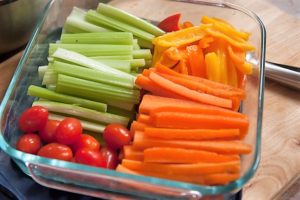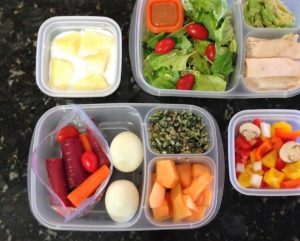Written by Hilary Rock BSc, Nutrition
Reviewed by Andrea Miller MHSc, RD
Before you get into the busy routine of going back to school, add nutrition planning to your schedule. By making nutrition a priority and being proactive in planning ahead, you can avoid the excuse of “not enough time” to eat healthy. Eating a nutritious breakfast, lunch and snacks helps to keep you and your children healthy and ready to learn. Whether you are going back to school yourself or your children are, use the following tips to minimize stress and maximize time management for a successful school year.
Make breakfast a priority
Eating breakfast is the best way to start the day, for children and adults alike. A good breakfast fuels you and gets you ready for the day. If a rushed morning routine keeps you from sitting down for breakfast, plan for breakfast on-the-go. Pre-prep breakfast foods the night before, for a grab -and-go meal, in the morning. A balanced breakfast doesn’t have to be time consuming.

To create a balanced breakfast, include three food groups, in your meal;
- Fruits and Vegetables: bananas, berries, apples, cucumber, peaches, spinach, mushrooms, frozen fruit, unsweetened applesauce
- Grain Products: whole grain cereals, oatmeal, whole wheat tortillas, whole wheat pancakes (make ahead and freeze)
- Milk and Alternatives: yogurt, cheese, cottage cheese, milk or milk alternatives (fortified soy milk or almond milk)
- Meat and Alternatives: eggs, tofu, chicken, almonds, seeds, peanut butter, almond butter.
A nutritious breakfast can be as quick and easy as a bowl of whole grain cereal with milk and sliced bananas or a yogurt berry smoothie with a handful of trail mix of nuts and seeds. Make sure to balance the breakfast with a protein and carbohydrate for lasting fullness and energy. Make a list of breakfast options and keep it handy for meal planning and grocery shopping
Be Prepared

Pack lunches the night before, so you can grab and go in the morning. Make lists, organize items, and have a plan. Prep meals and chop vegetables on the days when you are least busy. Having foods ready to use or eat will make meals a lot quicker. If you have children, they will more likely choose fruits and vegetables that are already cut and ready to eat.
Plan Quick and Healthy Lunches

Packing your own lunch from home is a smart way to save money and eat food you love. When making lunches include protein such as tofu, meat, fish, cheese or beans at each meal. Protein helps you feel full longer so you can focus on school until your next meal or snack. Wraps are a nice change of flavor and texture from the usual sandwich. Use whole-grain tortillas add mustard, hummus, some oil and vinegar-based dressing, or pesto sauce. Then fill your wrap with sliced grilled chicken or salmon or tuna, cheese, tomato, sliced onion and shredded Romaine lettuce. Another way to pack a wrap is to make it with Mexican style ingredients like guacamole, salsa, black beans, grilled chicken and brown rice. Just roll it up, wrap in foil and place it in your lunchbox. Leftovers make great quick and easy lunches too! Leftovers can be eaten as is or remade into a different meal. Include fresh fruit, raw or cooked vegetables, yogurt, hard boiled eggs, and whole grain crackers. Mix and match your favourite foods to create balanced meals to keep you energized throughout the school day.
Have the Proper Tools
Whether it be built in ice packs or sectioned containers, there are many great lunch box items to make packing lunches easy. Use specific containers for salads and yogurt parfaits that have separate sections to prevent food from getting soggy. There are even items out there to help make packing cutlery easy as well. By having the proper tools for your lunch box needs you will save time trying to pack everything into a lunch bag and will be better organized.
Pack Some Snacks

Snacks can be an important part of your day as they provide energy and nutrients, between meals. Planned snacks can decrease trips to vending machines or drive through’s, between classes. A healthy snack between meals can also decrease hunger and prevent overeating at meal times. Raw vegetables such as carrots, cucumbers, bell peppers, and cherry tomatoes, with hummus, makes a great snack. A bag of homemade trail mix complete with dry whole grain cereal, dried fruit, nuts and seeds makes for a portable and healthy snack.
Always Carry a Water Bottle

Keep a water bottle with you through out the day and at your desk; you are more likely to drink more, if you have water with you. Dehydration can decrease alertness, lead to headaches and make it more difficult to stay focused.
Click here for more healthy ideas for planning lunches.

